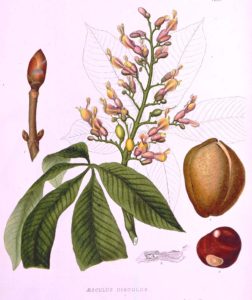When John Muir embarked on his one-thousand-mile walk from Indiana to Florida in 1867, most of the space in his pack was taken up by a single book—Manual of the Botany of the Northern United States, from New England to Wisconsin and South to Ohio and Pennsylvania inclusive. That manual generally goes by a shorter title, Gray’s Manual, written by Asa Gray. Through eight editions and to the present day, Gray’s Manual continues to be an essential resource for American botanists, well earning Asa Gray recognition as the “Father of American Botany.”
Asa Gray was born on November 18, 1810 (died in 1888), in Oneida County, New York. With seven younger siblings, Gray grew up working on the family’s farm and becoming an avid naturalist, especially interested in minerals. His interest in botany began while at school, causing his father to enroll him in a local medical school. He graduated in 1831 and opened a medical office—but that was the beginning and end of his medical career.
While in medical school, he had spent his spare time exploring the countryside and collecting plants, developing a sizable herbarium. He became acquainted with John Torrey, a chemistry professor and botanist at Columbia University. Shunning medical practice, he joined Torrey as his chemistry assistant—but they both pursued botany as their true avocations. When Torrey’s funds ran out, Gray drifted among various teaching positions over the next 15 years, but never stopped exploring the northeastern United States, gathering plant specimens, developing his herbarium, classifying new species and publishing papers on his findings.

In 1848, Gray was appointed to Harvard University as the first full-time professor of botany in the nation. He virtually created a botanical presence at Harvard, building a herbarium (now named for him), accumulating a botanical library and planting botanical gardens. He traveled widely throughout the United States and Europe (there he investigated specimens of American plants in European collections). In 1848, he published the monumental work mentioned above, the 800-page Gray’s Manual. That book was accompanied by many more, both fundamental science and more popularized works for the educated public.
His Manual became instantly popular (and remains so) for the clarity of its presentation, the accuracy of its taxonomic organization and the completeness of the treatment. As his 1889 obituary in the National Academy of Sciences read in part:
“Botanists themselves needed some one who could bring together the scattered materials of the early explorers and harmonize the writings of earlier botanists into a compact and comprehensive whole; one who could settle authoritatively doubtful points of nomenclature; who could describe species tersely and clearly so that there might be a good general account of the flora of North America comparable with similar floras of Europe. The public needed some one to tell them what botany itself was and what botanists were doing…. Combining the power of original research with a talent for popular exposition, he was just the man for the time.”

Gray became so popular and authoritative that he wielded substantial influence in philosophy, politics and religion. This became important when Charles Darwin’s work on natural selection and evolution started a scientific and cultural revolution (learn more about Darwin’s work here). Gray and Darwin were constant correspondents during this time, exchanging more than 300 letters. Darwin shared with Gray more than with any other scientists or friends. Gray was a devout Christian, but he held the belief that Darwin’s discoveries were wonderful and instructive—they showed the mechanisms that his Creator had put into place to organize the world. Gray had much to do with the eventual acceptance of Darwin’s ideas in the United States.
And Gray has had much to do with the development of botany and biodiversity coonservation in the country. He discovered and named hundreds of species. He published the first comprehensive treatment of the distribution of plants, establishing an understanding of how habitat conditions affect an area’s flora. He explored California with John Muir (learn more about Muir here). He bequeathed all his materials—herbarium and library—and all his royalties to Harvard University; today Harvard’s botanical collections remain one of the world’s largest and best. He was an original member of the National Academy of Sciences and other prominent scientific organizations. His nickname as Father of American Botany is well earned, but wouldn’t it be simpler to just call him “The Stamen”?
References:
Encyclopedia Britannica. Asa Gray, American Botanist. Available at: https://www.britannica.com/biography/Asa-Gray. Accessed October 30, 2018.
Farlow, W. G. 1889. Memoir of Asa Gray. National Academy of Sciences, April 17, 1889. Available at: http://www.nasonline.org/publications/biographical-memoirs/memoir-pdfs/gray-asa.pdf. Accessed October 30, 2018.
NNDB. Asa Gray. Available at: http://www.nndb.com/people/269/000102960/. Accessed October 30, 2018.
Sierra Club. Asa Gray. Available at: https://vault.sierraclub.org/john_muir_exhibit/people/gray.aspx. Accessed October 30, 2018.
University of Cambridge. Asa Gray. Darwin Correspondence Project. Available at: https://www.darwinproject.ac.uk/asa-gray. Accessed October 30, 2018.
